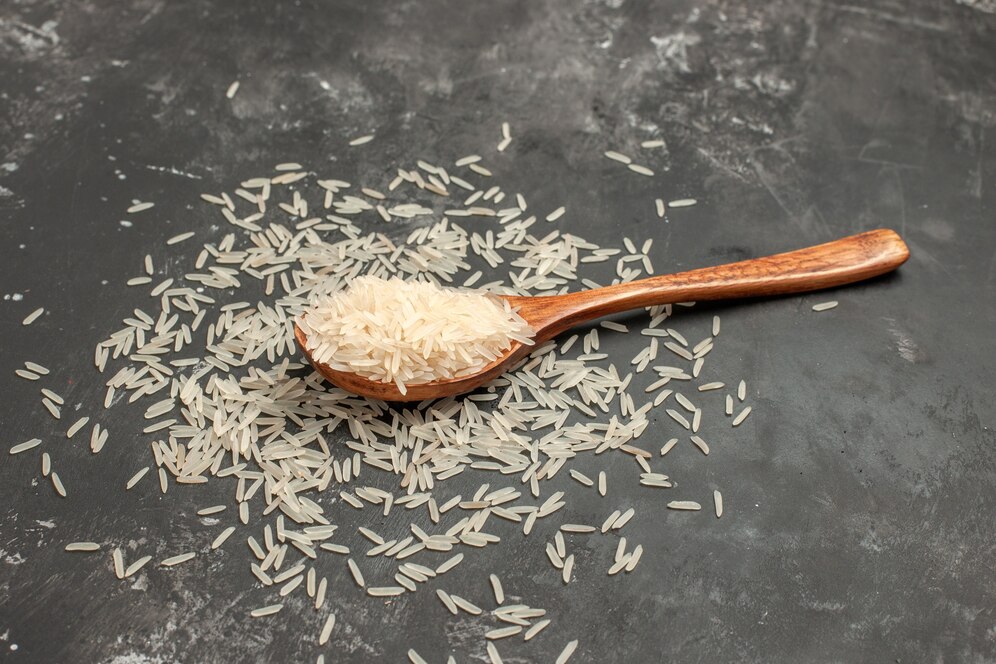
Basmati rice is one of the most valued rice varieties in the world, known for its unique aroma, long grains and subtle taste. Originating in India and Pakistan, this rice has become synonymous with luxury and quality in global cuisine. In this article, we will take a closer look at the properties of basmati rice, its fascinating history, interesting facts related to it and culinary inspirations that will allow you to use its full potential.
Aroma: Basmati rice has a unique, nutty and floral aroma, which is the result of the presence of a chemical compound called 2-acetyl-1-pyrroline. It is this compound that gives it its characteristic, recognizable smell. This aroma is especially intense when the rice is cooked, which makes each dish using it a unique experience.
Long grains: Basmati rice grains are exceptionally long and slender, which is its hallmark. When cooked, these grains can expand up to twice their length, while retaining their structure and not sticking together. This makes basmati rice ideal for preparing dishes that require a loose consistency.
Nutritional values: Basmati rice is rich in carbohydrates, protein, fiber and minerals such as iron, magnesium and phosphorus. It also has a lower glycemic index compared to other rice varieties, making it suitable for people watching their blood sugar levels. It's also worth noting that basmati rice contains low amounts of fat and is cholesterol-free, making it a healthy choice for people concerned about heart health.
Low fat: It is low-fat, which makes it an ideal choice for people who care about their figure. Additionally, basmati rice is naturally gluten-free, making it suitable for people with gluten intolerance or celiac disease.
Basmati rice has a long and rich history, dating back several thousand years. Its cultivation and consumption are deeply rooted in the culture of the Indian subcontinent. The name "basmati" comes from Sanskrit, where "bas" means fragrance and "mati" means full.
Ancient Roots: The first mention of basmati rice appears in ancient Sanskrit texts, where it was described as the "king of rices". Its cultivation was concentrated mainly in the regions of present-day India and Pakistan, where the climatic and soil conditions were ideal for this plant. This rice was grown in the valleys of the Indus and Ganges rivers, which offered fertile soil and a suitable climate.
Trade and Spread: As trade expanded on the Indian subcontinent, basmati rice became an important export. It was particularly appreciated in the Middle East and Europe, where its unique properties gained many fans. Traders and travelers from the Middle East, such as Arabs and Persians, brought basmati rice to their countries, where it quickly gained popularity.
Cultural Importance: In India and Pakistan, basmati rice is not only a food, but also a symbol of wealth and tradition. It is often used during important ceremonies and holidays such as weddings and festivals. Traditionally, basmati rice is served at formal meals and is considered a symbol of hospitality.
Royal Status: In ancient India, basmati rice was considered royal rice and was often served in imperial courts. It was also an important ingredient in the diet of maharajas. Basmati rice was often used in royal banquets and ceremonies, and its high price made it available only to the elite.
Unique Height: Ryż basmati jest znany z wyjątkowego wzrostu podczas gotowania – jego ziarna mogą wydłużyć się nawet dwukrotnie, co jest unikalne w świecie ryżu. Dzięki temu, po ugotowaniu, ryż basmati ma lekkość i puszystość, która wyróżnia go spośród innych odmian ryżu.
Legal Protection: Basmati rice is protected by a geographical indication in India, which means that only rice grown in certain regions can be sold as basmati. This helps protect the authenticity and quality of this rice variety. The geographical indication ensures that basmati rice comes from the region that is considered its homeland, which is important for maintaining its unique characteristics.
Ecology: Organic basmati rice, which is grown without the use of chemicals, has been growing in popularity in recent years, benefiting both health and the environment. Organic farming helps protect soil and water and reduces environmental pollution. Additionally, farmers growing organic basmati rice often use traditional farming methods that contribute to the preservation of biodiversity.
Basmati rice is extremely versatile and can be used in many different cuisines and dishes. Here are some culinary inspirations that will allow you to use the full potential of this unique rice.
Biriyani: This is one of the most popular basmati rice dishes. Biriyani is an aromatic dish that combines rice with meat (chicken, lamb, shrimp), yogurt, spices (such as saffron, cardamom, cinnamon) and vegetables. Each region of India has its unique version of biriyani, such as Hyderabadi biriyani, Mughlai biriyani and Kerala biriyani. Biriyani is known for its rich flavor and aroma that comes from long cooking of rice together with meat and spices.
Pilaf: Pilaf is aromatic rice cooked in broth with spices, vegetables, and sometimes meat or seafood. Popular in Middle Eastern and Central Asian cuisines, pilaf is perfect as a main course or side dish. Pilaf can be prepared in many ways, depending on the region - from Turkish mutton pilaf to Iranian pilaf with saffron and dried fruits.
Rice with coconut milk: Basmati rice cooked in coconut milk with spices such as cinnamon, cardamom and curry leaves. This dish is often served with curries, especially in South Indian cuisine. Coconut rice is delicate and aromatic, it goes perfectly with spicy and rich curries.
Basmati rice, with its unique properties, rich history and versatile culinary uses, is a real treasure among rices. Its unique aroma and delicate taste make it a favorite ingredient in both traditional dishes and modern cuisine. Regardless of the method of preparation, basmati rice always brings a note of exoticism and elegance to the dish, making each dish unique.